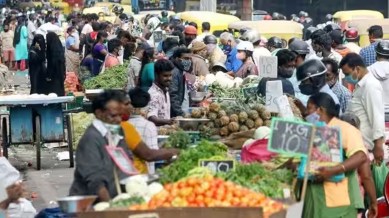High volatility in vegetable inflation haunts economy: Crisil report
Vegetables have 15.5 per cent weight in the food index, which is the highest after cereals and milk, and remains the most volatile component

With demand outpacing supply, vegetable inflation has trended up in the past four years with consumer price index (CPI) vegetable inflation averaging 5.7 per cent during fiscals 2020 to 2023, rating agency Crisil said.
On the other hand, CPI vegetable inflation averaged zero per cent during fiscals 2016 to 2019, with interim periods of sharp deflation and steep inflation, mostly led by weather shocks, it said. “Vegetable inflation in India has been trending up, with more frequent price spikes in recent years. In fact, vegetable inflation also has been the most volatile in the food category,” Crisil said.
monthly limit of free stories.
with an Express account.
In comparison, average food inflation rose to 6.2 per cent during fiscals 2020 to 2023 from 2.8 per cent between fiscals 2016 and 2019. 2. The frequency of vegetable price spikes has increased. In the past 100 months, CPI vegetable inflation was above its period average of 3.8 per cent in 49 months. It was above 7 per cent in 35 months, above 10 per cent in 30 months and above 20 per cent in 13 months.
“The inflation volatility is bad for consumers and farmers, and also distracts policymakers in the short term, forcing frequent and repeated price smoothening measures. Demand for vegetables has outpaced supply,” Crisil said. Population growth and demographic transition, income growth and the changing dietary preferences that come with it are some structural factors behind the surge in demand, it said.
While vegetable production — including per capita production — has grown, it has not kept pace with the surge in demand, Crisil said. Apart from losses due to weather disturbances and pest attacks, post-harvest wastages during storage and transportation further cut the stock available in the market, it said.
It said food inflation is back to haunt the Indian economy. After staying low in the June 2023 quarter, the hump in the September quarter (mainly due to higher vegetable and foodgrain inflation) and an uneven monsoon has changed India’s inflation narrative for this fiscal. But this is not the first time a vegetable price spike has driven up food inflation, Crisil said.
Vegetables have 15.5 per cent weight in the food index, which is the highest after cereals and milk, and remains the most volatile component. Besides, such spikes are frequent in India. The last time it lasted long (in double digits for seven months) was in fiscal 2020 such that the annual average vegetable inflation surged to 21.3 per cent, taking up average food inflation to 6.7 per cent. And back to double digits between March and September 2022, averaging 15 per cent, according to Crisil.
But a repeat this fiscal is unlikely, it said. The good news is vegetable price pressure has abated as inflation fell from its peak of 37.4 per cent in July to 3.4 per cent in September with fresh supplies entering the market. Prices of tomatoes (which was a major driving force) and of several other vegetables fell sharply by September. “Onion prices, though, remain a pressure point. The not-so-good news is that vegetable prices can surge afresh,” it said.
Measured by standard deviation, volatility in vegetable inflation, which was already high at 11.1 during fiscals 2016 to 2019, rose to 17.3 during fiscals 2020 to 2023. Food inflation volatility during the periods was much lower, at 2.9 and 3.4, respectively, it said.
Tomatoes, onions and potatoes (TOP) are the most consumed vegetables in India and make up more than a third of the CPI vegetables category. Hence, any sharp movement in TOP prices influences the movement in CPI vegetables inflation, Crisil said.
It said volatility in TOP inflation remains significantly high, and much above the overall vegetables category. In a recent study published in the RBI monthly bulletin, the Development Research Group notes: “Although TOP forms a small part of the CPI basket, the volatility in headline inflation is significantly driven by the volatility in TOP”.